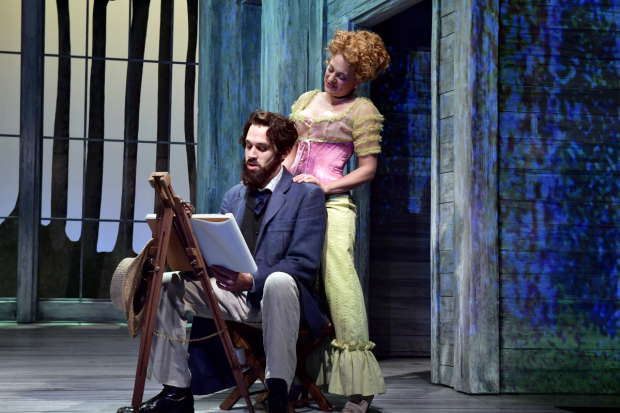Sunday in the Park With George

(© Paul Marotta)
Stephen Sondheim's take on the artist Georges Seurat's life and creativity was reimagined in the composer-lyricist's Sunday in the Park With George, which is currently running in a masterful revival at Huntington Theatre Company.
The 1985 Pulitzer Prize-winning musical is constructed in two parts: a first act about Georges Seurat (Adam Chanler-Berat) in 1884-1886 when he was engaged in making his famous painting A Sunday Afternoon on the Island of La Grande Jatte; and a second act that takes place 100 years later when his (fictional) great-grandson, George (Chanler-Berat), also an artist, is being fawned over by the art world establishment for his presentations called "chromolumes," a term that refers back to the 19th-century painter's theory of combining light and color.
Act 1 begins with Georges seated on the grass in the park where he is sketching his model, Dot (Jenni Barber), who is also his mistress. Gradually, Georges' gaze and sketchbook include his mother (Bobbie Steinbach) and her nurse (Amy Barker), and others who will be immortalized in his painting, to allow the audience to eavesdrop on their relationships and opinions. By the end of the act, Dot has moved on, despite her love and need for Georges. She understands that she — and the child she is carrying — will never be as important to him as his work.
Act 2 begins with the image of the painting, but dissolves into a 20th-century art gallery where great-grandson George is about to present his newest installation, the seventh in a series of chromolumes. When he is attacked by a snarky critic (Aimee Doherty, who also appears in Act 1 as the haughty wife of a rival) about repeating himself, and his technician (Nick Sulfaro) defects because he wants to move on to something new, George realizes that he is blocked as an artist. Although his 98-year-old grandmother, Marie (Barber), who was Dot's child, cannot go with him, he visits Paris for the first time, and he finds the inspiration to continue his work.
Huntington's production is stunning. Director Peter DuBois is aided enormously by the team of Derek McLane (scenery), Christopher Akerlind (lighting), Robert Morgan (costumes), and especially Zachary G. Borovay who designed the projections that turn the stage space from a blank canvas into the artist's landscape. DuBois envisions the painting as a frozen moment before the dance of a Sunday afternoon stroll, and enlisted the help of choreographer Danny Pelzig to bring the players to life.
Eric Stern, music director and conductor of the 11-piece pit orchestra, takes equal pride of place with Sondheim's score and lyrics, combining instruments and the voices of the ensemble into a ravishing choral sound. Chanler-Berat is particularly believable as the isolated, lonely Georges of Act 1, adrift in his own viewpoint. As Dot, Barber brings a feistiness and empathy to the character. As the pair sings out about their private desires and regrets, in contrast to their stilted verbal exchanges, we are touched by thoughts of what might have been.
Sondheim and book writer James Lapine can be excused for taking liberties with Seurat's biography for the sake of a universal story about an artist giving himself over entirely to his work. Wondering whether Sondheim meant the show as a commentary on his own life adds an intriguing subtext to this exquisite revival.











